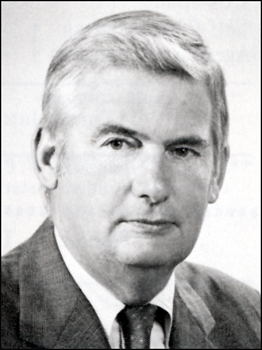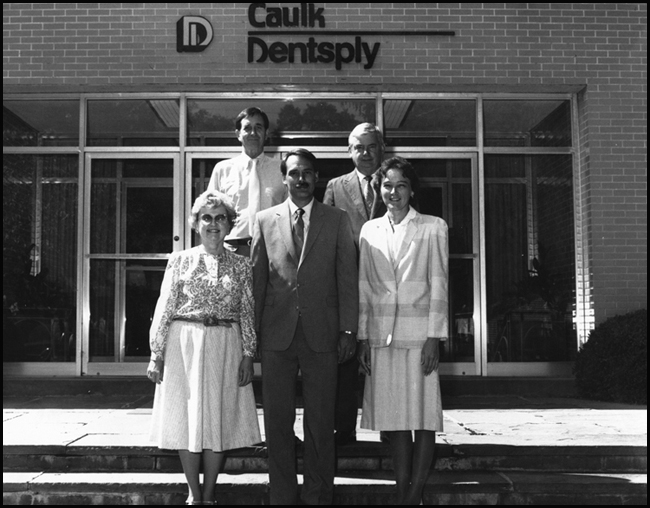In Memoriam
John B. Heyde, M.S.,
D.D.S.
1926-2017

The profession of dentistry lost an
outstanding member in January of 2017. Most of the current generation of
dentists would not know him and not too many of the gray-haired members
of the profession knew him either. But, his contributions to the
profession are evident in the daily practice of essentially all dentists
throughout the world. His name is Dr. John Bradley Heyde.
John B. Heyde was born on December 27, 1926
and passed away on January 26, 2017 at the age of 90 years. He earned a
Master of Science degree in Biochemistry from the University of Michigan
in 1952, followed by a Doctor of Dental Surgery degree from the same
institution in 1957. He began his dental career working in research and
product development with the L.D. Caulk Company in Milford, Delaware and
continued with DENTSPLY Caulk for many years until transferring later in
his career to DENTSPLY corporate headquarters (now Dentsply Sirona) in
York, PA. His primary contributions to the profession were in industrial
research and product development, and his contributions were numerous.
He had the opportunity to work with dentists
and researchers across the globe. The main focus of his work was in the
area of dental restorative materials and techniques. His work has had a
direct impact on patient care today and the ability of dentists to
deliver quality care.
He was a pioneer in the area of adhesive
dentistry and worked with Dr. Michael G. Buonocore1 to
develop enamel acid conditioning liquids, and later etchant gels, for
bonding restorative materials and sealants. Following the death of Dr.
Buonocore, Dr. Heyde worked with the Academy of Operative Dentistry to
establish the Buonocore Memorial Lecture at the Annual Session, which
allows the Academy to host an internationally recognized speaker each
year.
As an industrial research scientist/dentist,
Dr. Heyde was able to influence the care of patients throughout the
world. In the late 1970’s he was instrumental in developing the first
photoinitiated sealant and restorative material. These early materials
were photocured with a Nuva Lite using the ultraviolet wavelength.2-3
Because of some safety concerns and limited depth of cure with the UV
wavelength, he helped develop a visible light curing unit (Prisma Lite),
which used a quartz-tungsten-halogen light source, along with visible
light curing resin-based materials.4 He was an innovator in
visible light curing methods and materials. Dentists of today and their
patients have benefited greatly because of his contributions.
I had the privilege of working alongside Dr.
Heyde for three plus years from 1982-1985. After serving nine years as a
dental officer in the U.S. Air Force and three years as a faculty member
at Creighton University School of Dentistry, Dr. Heyde asked me to join
him in research and development at DENTSPLY Caulk. This was a wonderful
opportunity for me to be mentored by a very respected and talented
researcher in the field of restorative dentistry. I was also able to
work with dental materials researchers from around the world. But, most
of all, this research position gave me a close-up opportunity to learn
from Dr. Heyde. While we developed products for commercial sales, his
focus was always on “what will it do for the patient.” His primary
interest was developing materials and techniques to enhance patient
care.
During the time I was at DENTSPLY Caulk, the
use of resin composite in the posterior dentition was evolving. Clinical
studies were showing wear of early generation tooth-colored
restoratives when placed in posterior teeth.5 Dr. Heyde
worked with chemists and university colleagues to develop improved resin
composite materials and evaluation methods to monitor clinical
performance. He truly helped usher in the growing use of resin
composite for the posterior dentition and many patients and providers
have since benefited from his work in the early 1980’s. In the mid 80’s
he also helped to develop the first resin-based luting cements.6-7
So, while few in the practicing dental
community knew this innovative research dentist, his research
accomplishments, even today, have a daily impact on practicing dentists
and the care their patients receive. He also forever changed my life and
my professional career path. When I decided to depart from my industrial
research position and return to academia, he simply said “I understand.”
I will always be grateful for the time that my family and I shared with
our friend, John. I hope that by sharing my comments and perspective
that dental professionals will gain appreciation of his tremendous
contributions to dentistry during a life well lived.
Respectively,
Wayne W. Barkmeier, D.D.S., M.S.
Special Professor and Dean Emeritus
Creighton University School of Dentistry

Caulk Division of Dentsply International
Milford, Delaware
circa 1983
Top row (L-R):
Ralph Catts, CLT and Dr. John B. Heyde, Director of Clinical
Research
Bottom row (L-R): Josephine Wdowiak, Secretary, Dr. Wayne Barkmeier,
Intramural Research Manager and
REFERENCES
1. Buonocore MG. A simple method of
increasing the adhesion of acrylic filling to enamel surfaces.
Journal of Dental Research 34(6):849-853, 1955.
2.
Heyde JB. Ultraviolet light polymerized
restorative system: Clinical report.
Journal of Prosthetic Dentistry.
42(4):693-695, 1973.
3. Young
KC, Hussey M, Gillespie FC & Stephen KW. The performance of
ultraviolet lights used to polymerize fissure sealants.
Journal of Oral Rehabilitation
4(2):181-191, 1977.
4. Strassler H. The physics of light curing
and its clinical implications.
Compendium of Continuing Education in Dentistry 32(6):70-71, 2011.
5. Phillips RW,
Avery DR, Mehra R, Swartz ML
& McCune RJ. Observations on a composite for Class II restorations:
Three-year report. Journal of
Prosthetic Dentistry 30(6):891-897, 1973.
6. Barkmeier WW, Heyde JB & Holston AV.
Composite luting cements for resin-bonded appliances.
Journal of the Indiana Dental Association
62(6):13-17, 1983.
7. Cavel WT, Kelsey WP III, Barkmeier WW &
Blankenau RJ. A pilot study of the clinical evaluation of castable
ceramic inlays and a dual-cure resin cement.
Operative Dentistry
19(4):257-262, 1988.